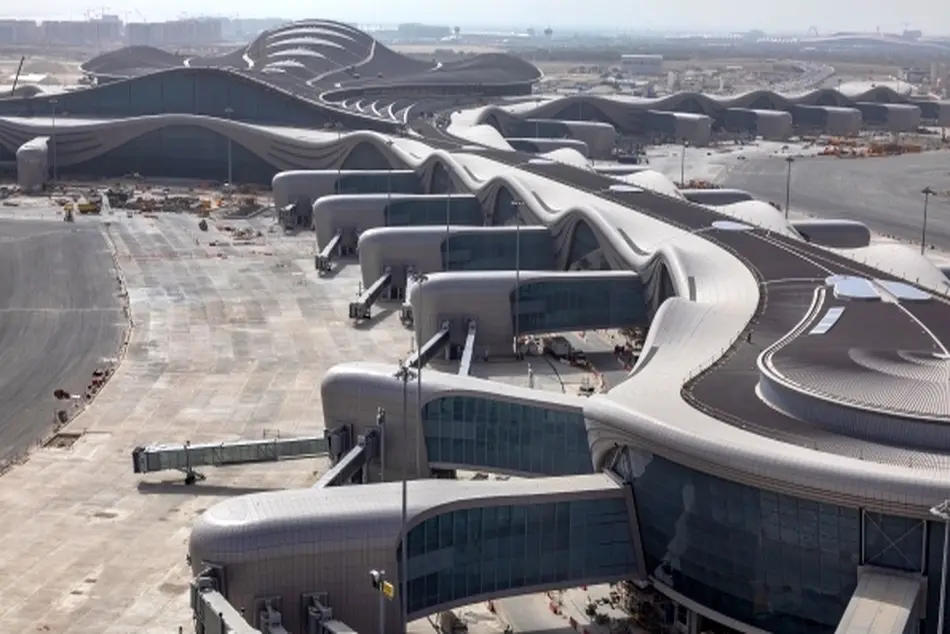Etihad Engineering Sets Out Long-Term Growth Plans
DUBAI—Etihad Engineering is targeting the doubling of revenues by 2030 along with adding significant hangar capacity in Abu Dhabi as part of a broader growth strategy.

DUBAI—Etihad Engineering is targeting the doubling of revenues by 2030 along with adding significant hangar capacity in Abu Dhabi as part of a broader growth strategy.
As part of an initiative called Al Masser—Arabic for “the path”—the Abu Dhabi-based company is setting out a large scope of initiatives aimed at growing the business both domestically and internationally, driving operational excellence and growing product capabilities in its portfolio.
Daniel Hoffmann, appointed CEO of Etihad Engineering in 2023, says the MRO provider is aiming to double its revenues from around $270 million at the end of 2023 to $540 million by 2030. Etihad says this has been driven by a “favorable MRO market” with increased demand for aircraft maintenance due to factors such as reduced OEM production, which has meant strong demand for in-service aircraft.
Since 2024, Etihad Engineering was acquired by Abu Dhabi Aviation. Hoffmann says Etihad Airways accounts for around 30% of the MRO’s overall work, with the remainder being third-party. “If we want to support Etihad with the growth which we have to do, and we don't want to dilute our third-party business, we’ll have to grow for the third-party market in the same way as we do for Etihad work,” he says.
Another factor is the fleet expansion of Etihad Airways, which plans to increase its fleet by another 80 aircraft by 2032, nearly doubling its current fleet size of around 100 aircraft. The carrier is also undergoing a major cabin reconfiguration program which is adding a heightened requirement for services.
“At the moment, we have two to three lines booked for Etihad Airways. In the near future, we expect this to increase to six and in certain locations maybe even up to eight parallel lines,” says Hoffmann, who adds this should occur between 2026-27.
Hoffmann notes several new airline customers last year, particularly from Europe, and says Etihad Engineering is targeting a geographically diverse customer portfolio. He pinpoints the Middle East, South America and Asia-Pacific as strong growth regions while also singling out India, following its addition of Air India as an MRO customer last year.
It will also look to nearly double labor-hour volumes from 1.78 million at the end of last year to around three million over the next five years. For 2025, it has budgeted for more than two million labor-hours, with two new hangars scheduled to be added this year.
With market demand still outstripping supply resulting in constrained slot availability worldwide, Etihad is planning to grow its hangar footprint at its Abu Dhabi base over the next few years. This process started last year with the company purchasing an Airbus A380 capable hangar from state fund Mubadala, which it has since leased to Etihad Airways for line maintenance purposes. The hangar, which can accommodate one widebody or several narrowbodies, will be incorporated into the MRO provider’s capacity in 2027.
In March, the company expects to complete its new hangar seven in Abu Dhabi, which will house Boeing 737-300ER passenger-to-freighter conversion work in partnership with Israel Aerospace Industries through an agreement signed in 2021. Hoffmann expects the hangar to be operational by May.
Another hangar, named 6D, will be added to its existing A380 hangar capacity by July, with volume for one widebody or a combination of multiple narrowbodies. Tentative plans are also afoot to add a further hangar able to accommodate up to five widebodies by 2028, with the project currently in the design stage.
“Within the widebody gaps, we would be able to squeeze in another three to four narrowbodies as well,” Hoffmann says of the further hangar addition. Construction is expected to begin in mid-2026.
Hoffmann also notes a lot of labor-hours for the Airbus A380 given its reactivation by Etihad, which currently operates seven of the superjumbos and plans to bring three more back into its fleet by the end of 2025. The company also conducts A380 maintenance for Australian airline Qantas and is in negotiations with an unnamed European operator about an A380 induction.
“The demand for A380 services is currently so strong that we recently decided to add another third parallel line of A380 overhauls,” Hoffmann reveals, with existing lines being reconfigured to accommodate the extra work. The new line will be added to Etihad Engineering’s existing A380 lines with capacity for two 12-year checks in parallel. “These are the heaviest checks in terms of man-hour consumption, with 100,000-man hours used in 100 days, so it’s a very stable and reliable business.”
To support its ramp-ups, Etihad Engineering intends to grow its 2,200 strong workforce. In 2026, before the hangar leased to Etihad Airways is incorporated into the engineering business’s capacity, it will need another 150-200 people to accommodate that scenario. By 2028 when all hangars are operational, Hoffman estimates staff numbers will far exceed 3,000 people.
Etihad Engineering highlights global capacity constraints, particularly in the base maintenance segment, and the supply is still facing significant disruptions despite relative improvements over the past year. “Waiting times for components and for cabin parts are still slowing us down,” says Hoffmann.
Another element of Etihad Engineering’s Al Masser strategy is driving operational improvements. Long-term, Hoffmann envisages improving the supply chain by evolving from a production-driven company to a more planning-driven organization. “On average, we see potential for densifying work in our existing infrastructure by about 10%,” he says, which it will target through initiatives such as optimizing work patterns, reallocation of staff wherever it is needed and the “flexibilization” of work designed to react to changing situations.
The company has also allocated one existing bay to trial and test a series of process improvements on an aircraft from the last week of February, aimed at reducing turnaround times and being more efficient. After reaching maturity, these processes will be rolled out across the wider organization. “We don't want to overwhelm the organization, so we will always look at achieving two or three improvements per check,” adds Hoffmann.
While possessing a broad airframe capability portfolio, Hoffmann says Etihad Engineering is next targeting A330neo base maintenance services and it is currently in discussions to do so. However, he says the company’s most substantial investment will be in its component repair portfolio. “The component market side has been, so far, mainly driven by the needs of the Etihad Airways fleet and to support them in areas such as wheels and brake shops and rescue and safety equipment. But we want to grow way beyond that,” he says.
Hoffmann says Etihad Engineering’s strategy will be to build up its OEM partnerships and create a multiple-OEM component solution shop in the Middle East. He highlights existing partnerships with Moog to carry out actuator testing and repairs, battery overhauls for Acme and a partnership signed last year with L3Harris focused on component repairs.
Etihad Engineering may also look at further MRO opportunities outside of Abu Dhabi, with India among the countries where it is exploring. It is also open to growing existing overseas ties with Argentina-based Fabrica Argentina de Aviones (Fadea), which has undertaken some maintenance checks in the South America region on behalf of Etihad Engineering since 2019. Hoffmann says it is currently in negotiations with Fadea to explore a stronger cooperation, which could result in a joint venture. He expects a decision on whether to proceed by the end of the first quarter.



